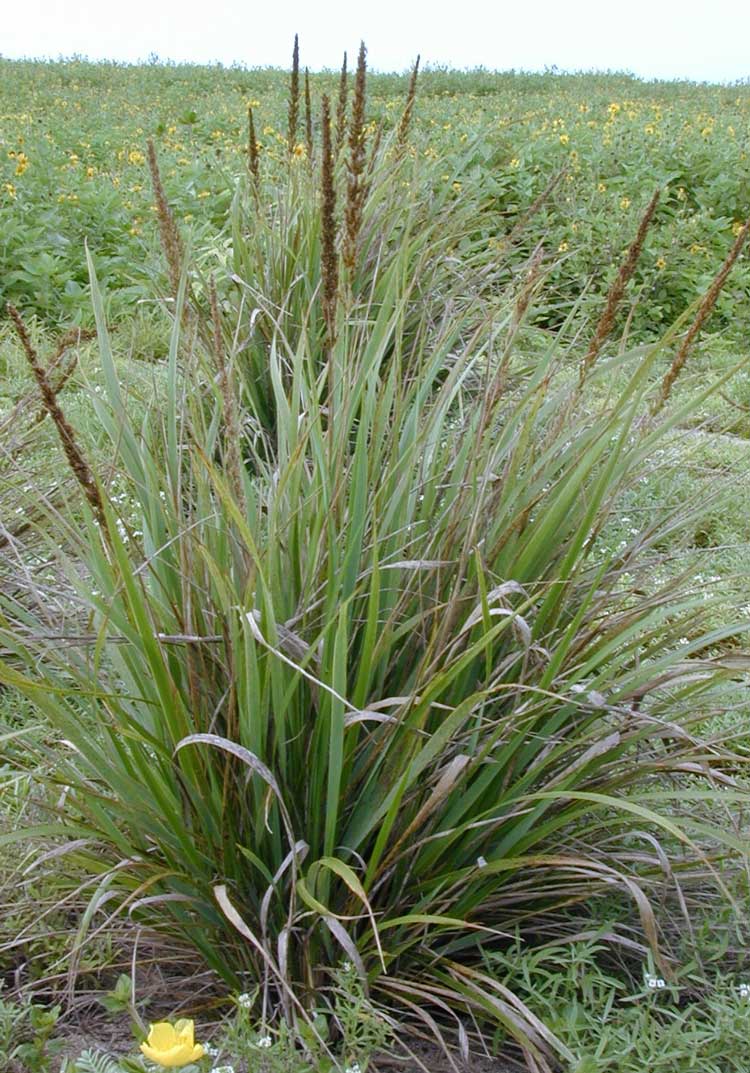
Eragrostis variabilis (Forest & Kim Starr)
Familia: Poaceae
Subfamilia: Chloridoideae
Tribus: Eragrostideae
Subtribus: Eragrostidinae
Genus: Eragrostis
Species: Eragrostis variabilis
Name
Eragrostis variabilis (Gaudich.) Hillebr.
References
Fl. Hawaiian Isl. 528. 1888 (E. G. Steudel, Nomencl. bot. ed. 2, 1:564. 1840, pro syn.)
USDA, ARS, Germplasm Resources Information Network. Eragrostis variabilis in the Germplasm Resources Information Network (GRIN), U.S. Department of Agriculture Agricultural Research Service. Accessed: 07-Oct-06.
Eragrostis variabilis is a species of grass known by the common names variable lovegrass, kawelu, emoloa, and kalamalo. It is endemic to Hawaii, where it occurs on all the main islands plus Kure Atoll, Midway Atoll, Pearl and Hermes Atoll, Lisianski Island, Laysan, and Nihoa.[1]
This species is a perennial grass which is variable in appearance. The smooth, erect stems are up to 3 feet tall or more. The leaves and inflorescences are variable in length. The panicles are open and spreading or dense and spike-shaped. Plants from the main islands look different from those growing on the other Hawaiian islands. There are about 3,136,000 seeds in a pound.[2]
This plant grows in several types of island habitat from dunes at sea level to ridges and cliffs at up to 3700 feet in elevation. It grows in areas that receive 40 to 100 inches of precipitation per year.[2]
On Laysan Island this plant provides the main nesting habitat for the rare Laysan finch (Telespiza cantans).[3] The bird hides its nest in clumps of the grass.[4] The grass also provides important nesting cover for the rare Laysan duck (Anas laysanensis). It is used by other bird species, such as the brown noddy (Anous stolidus), wedge-tailed shearwater (Puffinus pacificus), and red-tailed tropicbird (Phaethon rubricauda).[2]
This plant was used as thatching by Native Hawaiians. It is also used as an ornamental grass.[2]
This grass is displaced by the introduced weed sandbur (Cenchrus echinatus). This displacement reduces the amount of available nesting habitat for birds.[5]
Wikimedia Commons has media related to Eragrostis variabilis.
References
Eragrostis variabilis. NatureServe.
Eragrostis variabilis. USDA NRCS Plant Fact Sheet.
Morin, M. P.; Conant, S. (1990). "Nest substrate variation between native and introduced populations of Laysan Finches". The Wilson Bulletin. 102 (4): 591–604. JSTOR 4162932.
Morin, M. P. (1992). "Laysan Finch nest characteristics, nest spacing and reproductive success in two vegetation types" (PDF). The Condor. 94 (2): 344–57. doi:10.2307/1369207. JSTOR 1369207.
Flint, E. and C. Rehkemper. Control and eradication of the introduced grass, Cenchrus echinatus, at Laysan Island, Central Pacific Ocean, pp. 110–115 in Veitch, C. R. and M. N. Clout (Eds.) Turning the tide: The eradication of invasive species. IUCN SSC Invasive Species Specialist Group. IUCN, Gland, Switzerland and Cambridge, UK.
Retrieved from "http://en.wikipedia.org/"
All text is available under the terms of the GNU Free Documentation License

